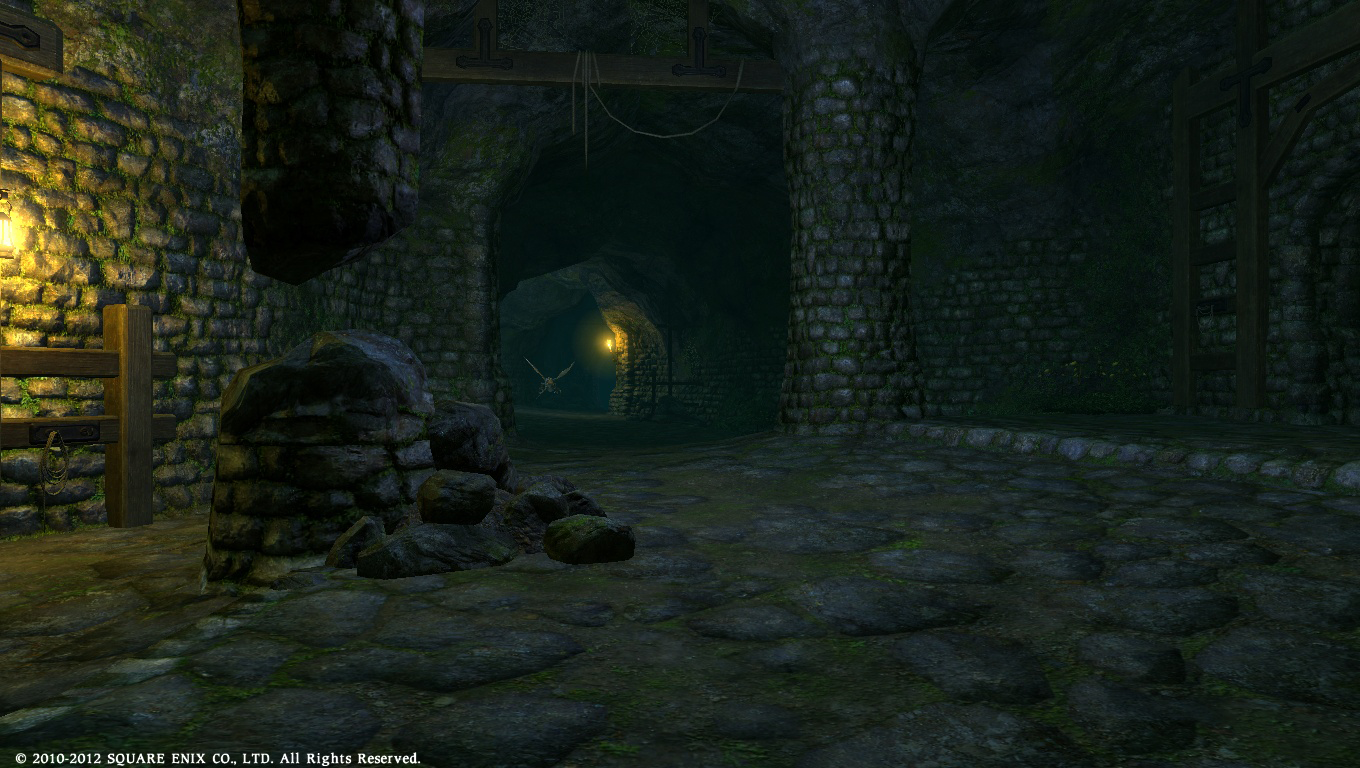I posted the following summary of Gelmorra on my FC sites forums, and thought it would be good to discuss it here as well. If anyone has further insight on Gelmorra or the other ancient civilizations of Eorzea, input and feedback would be most appreciated. The information came from various XIV sites and wikis, in addition to my own experiences in ARR and second-hand information from legacy players. Original post URL: http://gridania.shivtr.com/forum_threads/1556770
---Original Post: Ancient Civilizations, Gelmorra, and the Progenitors of Gridania---
The Floating City of Nym (La Noscea)
Ruins of Sil'dah (Thanalan)
Tam-Tara Deepcroft
It is known that there are at least 3 major ancient civilizations that existed in Eorzea in addition to the Great Allagan Empire. However, where these civilizations place in relation to each other is yet a mystery, though it is presumed that the Allagan Empire was dissolved (4th Astral Era) long before they themselves fell into ruin. Whether or not any of these civilizations reach back to Allagan times is unclear.
Remnants of these civilizations are still prominent in Eorzea today. The civilization of Nym is known for the various ruins left in La Noscea, most notably the end-game dungeon Wanderer's Palace and the nearby Floating City of Nym, while old aqueducts and other remnants of the great city-state of Sil'dih can be seen scattered throughout the southern deserts of Thanalan. It us unclear whether the latter was the creator of the now-sunken Temple of Qarn, or what link it has with the Belah’dian sultans who worshipped there during the Sixth Astral Era. Save some Belah’dian additions to the structure, we do know that Qarn was built long prior to Belah’dian occupation of Thanalan.
The last of these civilizations, the Gelmorra, inhabited the Black Shroud of antiquity and are the builders of the many ruins therein, including Spirithold, the Mun-Tuy Cellars, Tam-Tara, Toto-Rak, and Issom-Har. There is some confusion here as there is also brief mention of an Amdapori civilization in the shroud (builders of Amdapor Keep) which appear to have much in common with the Gelmorrans. As such, it is unclear whether these two people are one in the same, or if they are separate entities entirely.
What we do know concerning the Gelmorrans is that they were a primarily Elezen people, with a large Hyur minority. They may have had a mastery of magitek given the presence of the technology in Toto-Rak. However the origin of these devices is not certain, and it is not known whether Gelmorra developed the technology itself, inherited it from the Allagans, or if the devices found in Toto-Rak were introduced by someone else at a later time (i.e. the Garleans). The Gelmorrans had a strong mastery of magic, though apparently the abuse thereof led to the catastrophic flood which opened the Sixth Umbral Era. This flood forced most of the survivors to seal themselves into the nation's underground structures such as Tam-tara.
The underground exile of the Gelmorran survivors may have led to the distinction between the Wildwood and Duskwight Elezen as phases of emergence and diaspora from the shelters led to distinct evolutionary possibilities between those dwelling above and below the surface. According to the mining leve "Location, Location, Location" obtained at Quarrymill, the ruins of Gelmorra have "served as a necropolis...for half a thousand years," indicating that the last subterranean emigrants exited the caves at least 500 years ago (~year 1000 by the Eorzean calendar).
The first Padjal (the horned, elementally endowed hyur conjurers making up the Seedseers of Gridania) were born during the flood years after survivors banned the use of the old magics and established the art of conjury. It was during this time that these Gridanian progenitors first came into harmony with the Elementals and took on the responsibility of protecting and moderating the aetheric energies of the Black Shroud. It has been indicated that pre-flood Gelmorran society saw racial conflict between the majority Elezen and minority Hyurs, a problem which was also resolved during the shelter years. This new interracial good will is the inspiration for the crest of the Order of the Twin Adder, the two intertwining serpents symbolizing the coming together of equals in the common cause of Gridania.
Two great mysteries that endure today are the Gelmorran links with Ishgard and Odin:
First, it is unclear whether the elezen of Ishgard share a common Gelmorran ancestry, and whether their lineage comes before or after the flood. Given the highly stratified, elezen-dominated nature of Ishgardian society it seems highly likely that any Gelmorran-Ishgardian ancestral link predates the Sixth Umbral Era Calamity, resulting in the many racial stigmas preserved in Ishgard from old Gelmorra.
Second, concerning Odin, it is difficult to place contemporaneously with Gelmorra as his placement within the overall timeline of Eorzean history is unknown. It does seem likely, however, should Odin indeed be some fallen king or sage or old Gelmorra, that his ascension to primal status had some hand in the disastrous fall of the realm. This would also explain his stalking of the Black Shroud, and may even have a tie to Ramuh.
It is unclear what kinds of relations the Gelmorrans had with the old beast tribes, and neither Sylph nor Ixal have as of yet made mention of them.
Thread: Origin of Gridania: Gelmorra
-
09-17-2013 07:45 AM #1
Origin of Gridania: Gelmorra
(10)Last edited by GilbertLapine; 12-06-2013 at 05:58 PM.
-
09-17-2013 01:21 PM #2
-
09-17-2013 03:05 PM #3Player

- Join Date
- Dec 2012
- Location
- Ala Mhigo
- Posts
- 8,265
- Character
- Enkidoh Roux
- World
- Balmung
- Main Class
- Paladin Lv 90
Catapult could probably clarify things more clearly than I can, but from what I understand about Gelmorra, the whole civillisation existed simply because the elementals refused anyone to set foot in the Black Shroud (it's the same reason why the Ixal were driven out) - they were just too powerful. It was only when the moogles interceded on the Gelmorrans behalf that they were finally allowed to live on the surface in the Black Shroud, leading to the foundation of Gridania. Hence why Gelmorra was abandoned - it had simply served it's purpose.
And such things usually fall into ruin pretty quickly (just look at the actual 'Gelmorran Ruins' location in the North Shroud itself and compare it to it's 1.0 appearance - in 1.0 it was still rather substantial and complete, but now in ARR it's partially buried under rubble, a tree is growing out of the central pit and most of the columns are broken and strewn around the surrounding area.) so it's not surprising little is known about these things.
As for Toto-rak, that was technically not connected to the Gelmorran civillization, as Gridania built that as their main prison (a literal dungeon), but abandoned that when they built a new prison facility closer to Gridania itself.(0)Last edited by Enkidoh; 09-17-2013 at 03:08 PM.
-
09-17-2013 10:43 PM #4Player

- Join Date
- Oct 2012
- Posts
- 493
- Character
- Myranda Al'cyoene
- World
- Hyperion
- Main Class
- Conjurer Lv 80
Pretty sure Gridania did not build it, but only appropriated it for use as a prison. The very format of its name as Toto-Rak is evidence of its Gelmorran origin. Everything else in your post seems pretty spot on, and JGwinters took care of pointing out that the magitek was put there by the Garleans, so that covers all the major errors in the OP from what I saw.
The only thing I'll add right now isn't actually connected to the main Gelmorra part of the OP, but I believe most of the ruins around Thanalan trace back only to Belah'dia and not to Sil'dih. The only ruins I know of that can be definitively linked to Sil'dih itself is the ones explicitly named as the Sil'dih excavation site. In 1.0 there were Sil'dihn aqueducts inside Copperbell Mines, but that seems to have been retconned/omitted for ARR, as I haven't seen those reappear.(2)
-
09-18-2013 04:11 PM #5Player

- Join Date
- Dec 2012
- Location
- Ala Mhigo
- Posts
- 8,265
- Character
- Enkidoh Roux
- World
- Balmung
- Main Class
- Paladin Lv 90
Doh! You're right about Toto-Rak being Gelmorran originally, as it's design definitely is Gelmorran in appearence - I just went on what the Duty Finder description mentioned about it being an 'abandoned Gridanian prison' which seemed to suggest it was Gridanian-built.
Of course though, 'original construction' and 'simply reusing and rebuilding an earlier building constructed by someone else' are two totally different things, of which Toto-Rak is the later - after all, Gridania has done the same thing with Tam-Tara, reusing it as a place of internment for the dead of the Calamity.
Thank you for that clarification.
-
09-19-2013 03:11 AM #6Player

- Join Date
- Sep 2013
- Location
- Gridania
- Posts
- 13
- Character
- Yumie Alichia
- World
- Faerie
- Main Class
- Gladiator Lv 50
This is very informative and an awesome read for lore thirsting people like me.. thankies!!
A follow-up question.. and sorry if this was already addressed or discussed in other thread... do we know anything about the relationship (if any) between the beastmen tribes and these ancient civilizations?
Like did amalj'aa take side between Sid'lih and Ul'dah when they were at war against each other? Did Ixalis see Gelmorrans simply as outsiders or intruders of their homeland (Twelveswoods) before they themselves got kicked out?(0)
-
09-26-2013 09:22 PM #7Player

- Join Date
- Aug 2013
- Location
- Ul Dah
- Posts
- 16
- Character
- C'allikah Tahmoh
- World
- Mateus
- Main Class
- Pugilist Lv 70
The monk questline adds some info about the sil'dih v ul'dah wars and a few other battles as you investigate sites of battles for an archeologist as part of the story(you can question the npc further before and after the quests for more historical info about each site).
(0)
-
09-26-2013 10:51 PM #8Player

- Join Date
- Mar 2011
- Location
- Lotus Gardens
- Posts
- 3,240
- Character
- Thal Icebound
- World
- Ravana
- Main Class
- Dancer Lv 100
There are a few inaccuracies in here that I feel obliged to point out.
It was at the foundation of Gridania, not Gelmorra, that the distinction between Duskwight and Wildwood came to be. With the invention of modern Conjury, the wrath of the elementals against the civilisation abated, allowing those who lived beneath a violent forest to emerge in peace. Those that emerged from the underground cities to live in the sunlight developed the more tan tones and associated features. The duskwight arose from those elezen who did not wish to leave their underground homes behind.
We do not know if the padjal existed prior to Gridania's foundation. There is no question that they emerged the leaders of the new nation as a consequence of their aetherial sensitivity and ability to communicate with the elementals, but what role they could have played in Gelmorran society is unknown.
It is possible that the true guardians of white magic are the elementals themselves rather than the padjal, and that the Seedseers are more often than not the elementals' chosen wardens (YOU being the obvious exception). The White Mage quests before the calamity refer to the "pact of Gelmorra", suggesting it outlines rules of peace and non-violence that must be abided by the Seedseers specifically, implying that they only hold white magic and their elemental sensitivity because of it. Of course, this could use some clearing up, as the information available has been vague at best.
We do not know if Gelmorra existed prior to the sixth umbral era of the great flood. My guess is that it did not, rather that it was what remained after the fall of Amdapor during that Sixth Umbral Era. If that umbral era was caused by the abuse of white magic by the Amdapori civilisation, you can bet the resident elementals of the Twelveswood would not have humoured their ilk in the centuries that followed, forcing survivors underground and claiming the remnant secrets of white magic under their own protection.
Many Gelmoran ruins bear padjali nomenclature, strongly indicating that padjal names are a remnant of Gelmorran traditions and the hyur civilisation of the day. In fact, many could have easily been re-purposed after their were no longer needed for residential purposes, transforming them into cellars, jails, crypts and the like. The ruins also bear the symbol of the entwined adders (but without the lotus flower), symbolic of the union between Hyur and Elezen - something that likely translated from Gelmorran society to Gridanian society.(4)
-
12-06-2013 05:59 PM #9
Interesting stuff. Do you have any primary sources you can point me to (quest stubs, dialogue, etc.)? Most of the info I've found is second-hand through XIV wikis and the like, I'd really like to get my hands on some direct source material if its out there. I've found a few pieces of 'direct' information from DoL quests in south shroud, and a few tidbits about amdapor keep, but I've struggled to establish the fact from rumor.
For instance, I'd really like to establish a solid answer to this question: are the amdapori contemporaries, successors, or progenitors of the gelmorrans? Or, are they one in the same?(0)Last edited by GilbertLapine; 12-06-2013 at 06:03 PM.
-
12-07-2013 06:01 PM #10Player

- Join Date
- Mar 2011
- Location
- Lotus Gardens
- Posts
- 3,240
- Character
- Thal Icebound
- World
- Ravana
- Main Class
- Dancer Lv 100
A lot of it comes pieced together from a combination of in-game text and then joining the dots based on what you see and hear.
It is helped along significantly by what This Guy has had to say on many an occasion. You may want to look at the list of his posts and have a nice read.
Here are some old threads that may interest you. Keep in mind that they all pre-date the launch of ARR:
The meaning of Gridania's Arms.
First encounters with the City of Nym.
A Moonkeeper with the name of a Sunseeker.
The behemoth that is the "CG-Midlander thread." Pages 23 & 71 especially.(0)







 Reply With Quote
Reply With Quote








